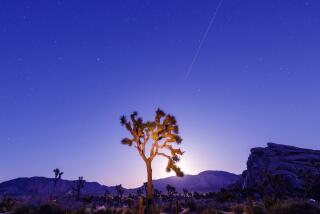Even small black holes emit gravitational waves when they collide, and LIGO heard them
LIGO scientists say they have discovered gravitational waves coming from another black hole merger, and it’s the tiniest one they’ve ever seen.
The findings, submitted to the Astrophysical Journal Letters, could shed light on the diversity of the black hole population — and may help scientists figure out why larger black holes appear to behave a little differently from the smaller ones.
“Its mass makes it very interesting,” said Salvatore Vitale, a data analyst and theorist with the LIGO Lab at MIT. The discovery, he added, “really starts populating more of this low-mass region that [until now] was quite empty.”
Gravitational waves are ripples in the fabric of space-time that are caused by accelerating or decelerating objects. They’re extremely difficult to detect, but worth searching for because they allow us to directly study extremely powerful cosmic phenomena — including black holes, which can’t be seen by conventional means because no light can escape from within the event horizon.
The Laser Interferometer Gravitational-Wave Observatory, or LIGO, can find black hole binaries — a pair of black holes that are bound by gravity — as they spin toward each other and violently merge into a single black hole. LIGO consists of two L-shaped detectors with 2.5-mile-long arms, one in Hanford, Wash., and the other in Livingston, La. When a gravitational wave passes through the detectors, squeezing one arm and stretching the other, a finely tuned system of lasers and mirrors inside the arms can pick up those infinitesimally tiny distortions.
Since finding its first black hole merger in September 2015, LIGO has announced the discovery of several more black hole mergers, as well as a merger of two neutron stars — some of which the European Virgo detector picked up as well.
The black hole smashup GW170608 was detected on the evening of June 7. The detectors measured a signal that came from the violent collision of two smaller black holes, about seven and 12 times the mass of the sun, sitting roughly a billion light-years away. The merger left behind a black hole with 18 solar masses; the remaining one sun’s worth of mass was converted into gravitational waves.
This event was quite small compared to most of LIGO’s other black-hole merger finds (for example, the first pair in September 2015 weighed in at about 36 and 29 suns respectively). The next smallest was found in December 2015, with black hole masses of 7.5 and 14.2 suns, respectively.
As the lowest-mass of LIGO’s black-hole finds, GW170608’s lightweight pair is in the same class as black holes that astronomers have found indirectly via X-rays and other high-energy radiation.
Those X-rays come from outside a black hole, as all the material in its accretion disc spins around, rubs against other material and heats up, emitting high-energy radiation in the process. That material in the disc is pulled from a companion star that’s gravitationally locked into a binary pair with the black hole.
But astronomers have really only spotted X-rays coming from lower-mass black holes, not the more massive ones such as those LIGO is finding.
Why haven’t larger black holes been found producing X-rays? It’s a mystery that researchers have yet to figure out, Vitale said. But GW170608 could help bridge that gap in our understanding.
LIGO is set to start its next observing run in late 2018, and as it finds more black hole mergers, scientists will start to be able to treat them as a population and study their demographics, to further probe these questions. But Vitale said he was also hoping to see something new, beyond black hole mergers and neutron star mergers.
“I would love to find a black hole and a neutron star,” he said.
Such a hybrid merger would allow scientists to study gravitational waves, but would also produce some light that astronomers could study with more conventional telescopes.
“If we see that,” he added, “we’ll learn a lot.”
Follow @aminawrite on Twitter for more science news and “like” Los Angeles Times Science & Health on Facebook.
MORE IN SCIENCE:
Just like humans, chimpanzees warn others of impending danger
This new satellite could produce the most accurate weather predictions yet
Organic agriculture can help feed the world, but only if we eat less meat and stop wasting food







